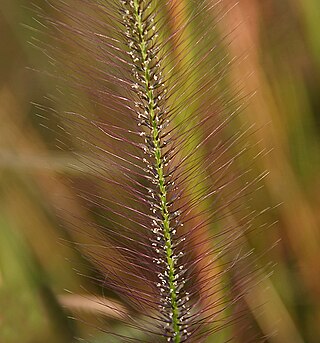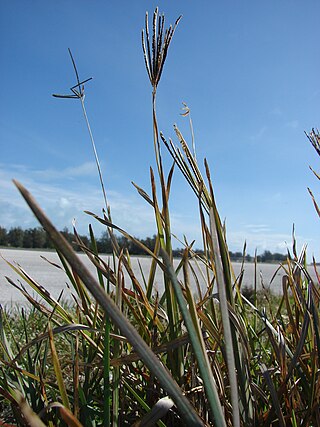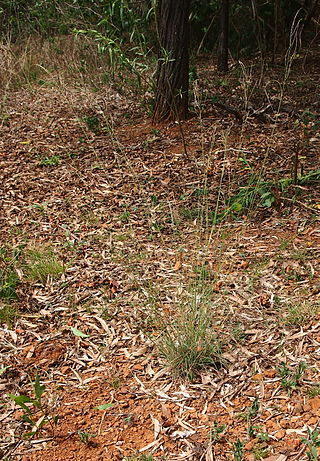
Royal Botanic Gardens, Kew is a non-departmental public body in the United Kingdom sponsored by the Department for Environment, Food and Rural Affairs. An internationally important botanical research and education institution, it employs 1,100 staff. Its board of trustees is chaired by Dame Amelia Fawcett.

Saccharum is a genus of tall perennial plants of the broomsedge tribe within the grass family.

Hepatica is a genus of herbaceous perennials in the buttercup family, native to central and northern Europe, Asia and eastern North America. Some botanists include Hepatica within a wider interpretation of Anemone.

Selenicereus, sometimes known as moonlight cactus, is a genus of epiphytic, lithophytic, and terrestrial cacti, found in Mexico, Central America, the Caribbean and northern South America. The term night-blooming cereus is also sometimes used, but this is also used for many night-blooming cacti, including Epiphyllum and Peniocereus. In 2017, the genus Hylocereus was brought into synonymy with Selenicereus. A number of species of Selenicereus produce fruit that is eaten. The fruit, known as pitaya or pitahaya in Spanish or as dragon fruit, may be collected from the wild or the plants may be cultivated.

Eriophorum is a genus of flowering plants in the family Cyperaceae, the sedge family. They are found in the cool temperate, alpine, and Arctic regions of the Northern Hemisphere, primarily in the middle latitudes of North America, Europe, and Asia.

Nomocharis was a genus of flowering plants in the family Liliaceae. It consisted of about 7 species native to montane regions of western China, Myanmar, and northern India. They are similar to Lilium, with one of the more obvious differences being the flowers being more shallow or sometimes flat.
Leucas flagellifera is a species of flowering plant in the family Lamiaceae. It is endemic to Socotra. Its natural habitat is subtropical or tropical dry shrubland. The scientific name has been misspelt as Leucas flagellifolia.

Phaedranassa is a genus of South American and Central American plants in Amaryllis family, subfamily Amaryllidoideae.

Cynosurus is a genus of Eurasian and North African plants in the grass family. Plants in this genus are known generally as dogstail grass. They are native to the Mediterranean Basin and neighboring regions, but some have been introduced into Australia as well as North and South America.

Chloris is a widespread genus of monophyletic grasses belonging to the family Poaceae, known generally as windmill grass or finger grass. The genus is found worldwide, but especially in the tropical and subtropical regions, and more often in the Southern Hemisphere. The species are variable in morphology, but in general, the plants are less than 0.5 m in height. They bear inflorescences shaped like umbels, with several plumes lined with rows of spikelets. The genus is characterized by the series of sterile florets above the lowest fertile ones, spikes usually 4–10 in numbers, approximated or in a slightly separated series of 10–20 spikes, rarely an indefinite numbers of terminal spikes. In India, 11 species are known to occur in which only two are endemic viz. Chloris wightiana Nees ex Steud. and Chloris bournei Rangachariar & Tadulingam.

Perotis is a genus of Asian, African, and Australian plants in the grass family.

Eustachys is a genus of tropical and subtropical plants in the grass family. It is native primarily to warmer parts of the Americas, with a few species in Africa and Asia.
Perotis ornithocephala is a species of flowering plant in the grass family Poaceae, native to India and Sri Lanka. When placed in the monotypic genus Lopholepis as Lopholepis ornithocephala, it was the only species.

Leptochloa is a widespread genus of Asian, Australian, and American plants in the grass family.

Solenangis is a genus of flowering plants from the orchid family, Orchidaceae. It is native to sub-Saharan Africa.

Lumnitzera is an Indo-West Pacific mangrove genus in the family Combretaceae. An English common name is black mangrove. Lumnitzera, named after the German botanist, Stephan Lumnitzer (1750-1806), occurs in mangroves from East Africa to the Western Pacific, and northern Australia.

The World Checklist of Selected Plant Families was an "international collaborative programme that provides the latest peer reviewed and published opinions on the accepted scientific names and synonyms of selected plant families." Maintained by the Royal Botanic Gardens, Kew, it was available online, allowing searches for the names of families, genera and species, as well as the ability to create checklists.

Callitriche palustris, the vernal water-starwort, narrow-fruited water-starwort, or spiny water starwort, is a species of aquatic plants. It is the type species of its genus.

Diplachne fusca, called bearded sprangletop, is a widespread species of grass in the genus Diplachne, native to North America, the Caribbean, South America, Africa, Asia, and Australia, and introduced in Europe, New Zealand and Hawaii, among other places. It prefers to live in salty, wet conditions, such as in salt marshes and shallow depressions.
Barkworthia is a genus of flowering plants belonging to the family Poaceae. It contains a single species, Barkworthia stillmanii, a perennial grass native to California.
















